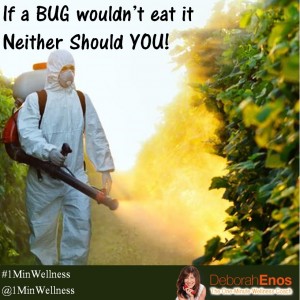
23 Apr If A Bug Wouldn’t Eat It, Neither Should You!

- Toxicity of the pesticide
- Amount of exposure
- Your age
- Your lifetime exposure to other toxins.
The key is to understand that even small doses of pesticide can harm people, especially during childhood! Because long-term effects are not known, it’s best to minimize your family’s exposure. Even small changes in eating habits can greatly diminish your exposure to these toxins.
According to a study by The Environmental Working Group:
“People can lower their pesticide exposure by 90 percent by avoiding the top 12 most contaminated fruits and vegetables and eating the least contaminated instead. Eating the 12 most contaminated fruits and vegetables will expose a person to nearly 20 pesticides per day, on average. Eating the 12 least contaminated will expose a person to a fraction over 2 pesticides per day.”
The 12 most contaminated fruits and veggies are: Apples, bell peppers, celery, cherries, grapes (imported), nectarines, peaches, pears, potatoes, spinach, strawberries and raspberries.
In the EWG study, peaches and raspberries were found to have the most pesticides, with 9 on a single sample, followed by strawberries and apples with 8!
Fruits and veggies are very important to include in your diet and this study is not trying to discourage you from consuming them. Instead, it encourages you to buy organic to reduce the risk of extra toxins building up in your body.
If you’re lucky enough to live in a city that has a year-round farmer’s market (I’m jealous!), this would be an excellent place to push your hard earned dollar to the max. At farmer’s markets you can also get produce that is “almost organic;” it’s a product that has been grown without chemicals, but the farm has yet to pass all organic guidelines. Ask the farmers, they are your best resource for getting the best (and safest) produce at the best price.
Another surprising place to get fresh organics is a home delivery service. While this sounds like a luxury, the prices are actually very reasonable and some of the services I checked out were actually cheaper than buying them at the supermarket. Most medium to large cities will have a few of these companies to choose from.
Please note that in this study the researchers did wash the produce. They discovered that while washing helps reduce some pesticide exposure, it in NO WAY eliminates the majority of it, since much of the pesticide is retained within the cells of the produce.
I often get asked about using a Fruit and Veggie detergent wash. People want to know if this product worth the money in this economy. I must admit that even as a nutritionist, I don’t always wash my produce as well as I should. I get in a hurry, I have hungry teenagers breathing down my neck and I just do the cursory quick wash of the lettuce, chop it and into a bowl it goes. In this age of salmonella food recalls, perhaps it is time to take a look at how we wash our veggies.
According to the website, Partnership for Food Safety Education, a good and long cleaning of produce under water should do the trick. Most people don’t wash their produce long enough to really clean the product. One expert wrote that as many as twenty people have touched the produce before you did, from the farmer to harvesting to transporting it to the market. I must admit, after reading that information, I have taken much more time and care with cleaning my produce.
Here are their tips for cleaning produce at home:
- Rinse fresh fruits and vegetables under running tap water, including those with skins and rinds that are not eaten.
- Packaged fruits and vegetables labeled “ready-to-eat,” “washed” or “triple washed” don’t need to be washed. (But I still do give it a quick rinse.)
- Rub firm-skin fruits and vegetables under running tap water or scrub with a clean vegetable brush while rinsing with running tap water.
- Dry fruits and vegetables with a clean cloth towel or paper towel.
- Never use detergent or bleach to wash fresh fruits or vegetables. These products are not intended for consumption.
If you do decide to use a “produce cleaning product” there are some great products on the market; they are usually sold right in the produce department of your supermarket. There are also many recipes on the internet for making your own produce cleaning product. This one below looks great and I will be giving it a try in my home.
You will need a spray bottle, one tablespoon of freshly squeezed lemon juice, 2 tablespoons vinegar, and 1 cup water. Put the ingredients in the spray bottle and shake well. Spray on your produce, and rinse well.
So what’s safe to eat? Well, according to the same study, the 12 least contaminated fruits and veggies are: asparagus, avocados, bananas, broccoli, cauliflower, sweet corn, kiwi, mangos, onions, papaya, pineapples and peas. These are safe to eat even if not grown organically. But, don’t forget to wash them!






The Duties of a Certified Nursing Assistant
Posted at 07:41h, 24 Aprilthis post is very useful thx!